
The Walter H. Gale House, located in the Chicago suburb of Oak Park, Illinois, was designed by Frank Lloyd Wright and constructed in 1893. The house was commissioned by Walter H. Gale of a prominent Oak Park family and is the first home Wright designed after leaving the firm of Adler & Sullivan. The Gale House was listed on the U.S. National Register of Historic Places on August 17, 1973.
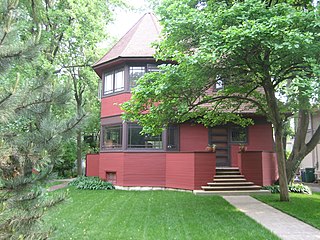
The Robert P. Parker House is a house located in the Chicago suburb of Oak Park, Illinois, United States. The house was designed by American architect Frank Lloyd Wright in 1892 and is an example of his early work. Real-estate agent Thomas H. Gale had it built and sold it to Robert P. Parker later that year. The house was designed by Wright independently while he was still employed by the firm Adler & Sullivan, run by engineer Dankmar Adler and architect, Louis Sullivan; taking outside commissions was something that Sullivan forbade. The Parker House is listed as a contributing property to a U.S. federally Registered Historic District.
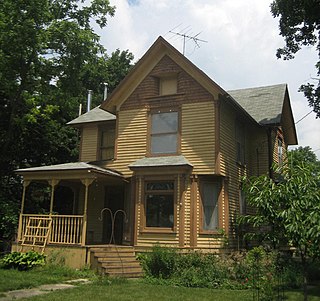
The Stephen Wright House is a home located in the Lee County, Illinois, United States, village of Paw Paw. The Queen Anne style home was constructed sometime between 1895 and 1906 by Paw Paw real estate speculator Stephen Wright. Located along a former Native American trail and stagecoach line, the home is in an area of very similar Queen Anne style homes which may have also been built by Wright. Wright had left the property by 1906 and sold the property to another Paw Paw resident who stayed in the house until his death. The Stephen Wright House was listed on the U.S. National Register of Historic Places on May 22, 2005.

This is a list of the National Register of Historic Places listings in Wright County, Minnesota. It is intended to be a complete list of the properties and districts on the National Register of Historic Places in Wright County, Minnesota, United States. The locations of National Register properties and districts for which the latitude and longitude coordinates are included below, may be seen in an online map.
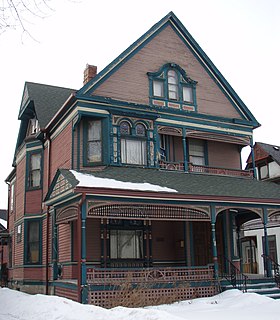
The Bennett–McBride House is a house in the Central neighborhood of Minneapolis, Minnesota, United States. It is listed on the National Register of Historic Places and is a contributing property to the Healy Block Residential Historic District. This house was listed on the National Register in 1977, before the rest of the block was listed in 1993.

The Albert Lammers House is a historic house in Stillwater, Minnesota, United States, built circa 1893. It was listed on the National Register of Historic Places in 1982 for having local significance in the themes of architecture and industry. It was nominated for its association with a local family that expanded Stillwater's lumber interests into northwest Minnesota, and as the city's leading example of Queen Anne architecture.

The Comstock House is a historic house museum in Moorhead, Minnesota, United States. It was built for Solomon Comstock and his family from 1882 to 1883 in a mix of Queen Anne and Eastlake style. Comstock (1842–1933) was one of Moorhead's first settlers and an influential figure in business, politics, civics, and education in the growing city and state.

The Eagle Newspaper Office is a historic commercial complex in Delano, Minnesota, United States, comprising three adjacent buildings constructed 1883–1885. It served as the headquarters of the Delano Eagle newspaper and a print shop specializing in railroad and commercial printing, as well as bookbinding. It was listed on the National Register of Historic Places in 1979 for having local significance in the theme of communication. It was nominated as the home of Delano's oldest business and a newspaper that had served the community continuously since its founding in 1872.
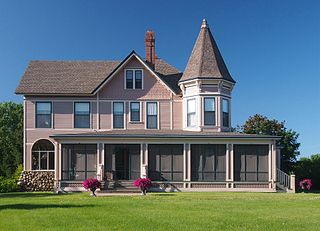
The Rand House, nicknamed "Random", is a historic house in Monticello, Minnesota, United States, constructed in 1884 and now operating as a bed and breakfast. It was the centerpiece of a summer estate owned by Minneapolis businessman Rufus Rand, Sr., and his wife Susan Mealey. The Rand House and a nearby building were listed on the National Register of Historic Places in 1979 as the Rufus Rand Summer House and Carriage Barn for having local significance in the themes of architecture, commerce, and entertainment/recreation. They were nominated for being representative of the late-19th-century country estates built by Twin Cities businessmen, their Queen Anne architecture, and association with Rand, a prominent utility executive.
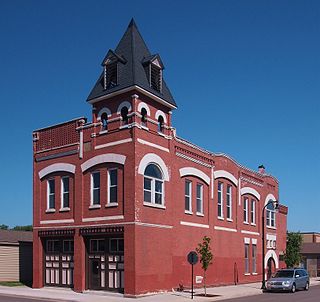
The original Delano Village Hall is a historic government building in Delano, Minnesota, United States, now in development as the Delano Heritage Center. From its construction in 1888 through most of the 20th century the building housed municipal offices, the police and fire departments, and a public library, while the upper-floor meeting hall was a key venue for public and private events. It was listed on the National Register of Historic Places in 1979 for having local significance in the themes of architecture and politics/government. It was nominated for being a typical example of Minnesota's municipal buildings of the late 19th and early 20th century, and for its longstanding centrality to government and civic functions in Delano.

The David Hanaford Farmstead is a historic farm in Monticello Township, Minnesota, United States. It was first settled in 1855 and features a farmhouse built in 1870 and a barn from around the same time. The farmstead was listed on the National Register of Historic Places in 1979 for having local significance in the themes of agriculture and exploration/settlement. It was nominated for being "an excellent example of an early Wright County farmstead developed by a pioneer family from New England."

The Dr. E.P. Hawkins Clinic, Hospital, and House comprise a historic former medical complex in Montrose, Minnesota, United States. Hawkins established his medical practice in 1897 in the front room of his residence. As his practice grew, however, he had a ten-bed hospital constructed next door in 1903, and ten years later acquired an adjacent building to use as a clinic and nursing school. The three-building complex was listed on the National Register of Historic Places in 1979 for having local significance in the theme of health/medicine. It was nominated for exemplifying Wright County's medical facilities at the turn of the 20th century.

The Lund–Hoel House is a historic house museum in Canby, Minnesota, United States. The residence and an adjacent carriage house were built in 1891 for John G. Lund (1868–1908), an influential land speculator, banker, and politician. Lund had the house extensively enlarged and remodeled in 1900. The property was listed on the National Register of Historic Places as the John G. Lund House in 1978 for having local significance in the themes of architecture and exploration/settlement. It was nominated for its association with Lund—who was instrumental in the settlement of Yellow Medicine County, established several banks in the region, and served as mayor of Canby—and as a fine example of Queen Anne architecture.

The Nicherson–Tarbox House is a historic house in Monticello, Minnesota, United States. It was built in 1889 in a blend Queen Anne and Shingle Style architecture. A barn was moved to the rear of the lot around the turn of the 20th century to serve as a carriage house, now a detached garage. The property, which contained a second outbuilding that is no longer extant, was listed on the National Register of Historic Places in 1979 as the Nicherson–Tarbox House, Shed and Barn for having local significance in the theme of architecture. It was nominated for being a prominent and well-preserved example of Queen Anne and Shingle Style architecture in Monticello.

The Abner F. Hodgins House is a historic house in Winona, Minnesota, United States. It was built in 1890 for Hodgins (1826–1896), a successful lumber executive. The house was listed on the National Register of Historic Places in 1984 for its local significance in the themes of architecture and industry. It was nominated for being an outstanding example of a Queen Anne-style house and for being the home of a notable leader in the key industry behind Winona's early prominence.

The William R. Wolf House is a historic house in Waseca, Minnesota, United States. It was built around 1895 and served as the family residence of a prominent local merchant and civic leader. It was listed on the National Register of Historic Places in 1982 for its local significance in the theme of architecture and commerce. It was nominated for being Waseca's leading example of the larger residences erected by its prosperous merchant class and of Queen Anne architecture.

Lake City City Hall is the seat of government for Lake City, Minnesota, United States. It was built in 1899 and later expanded with a large addition. The original section was listed on the National Register of Historic Places in 1981 for its local significance in the themes of architecture and politics/government. It was nominated for being Lake City's most architecturally prominent public building and its longstanding government center.

The Newington Gilbert House is a historic house in Afton, Minnesota, United States. It was built in 1864 in what was then the separate community of Valley Creek. The house was listed on the National Register of Historic Places in 1982 for its local significance in the themes of architecture and exploration/settlement. As one of the original houses in Valley Creek, it was nominated for helping to depict one of the many small Washington County settlements that formed around a commercial venture—though one that never progressed to formal platting—and the community's two-decade preference for Greek Revival architecture. Valley Creek was later formally incorporated into Afton.
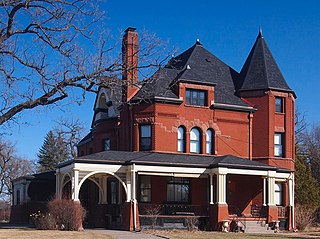
The Nehemiah P. Clarke House is a historic house in St. Cloud, Minnesota, United States. It was built in 1893 for Nehemiah P. Clarke (1836–1912), who arrived in St. Cloud as a pioneer in 1856 and made his fortune in retail, lumbering, and other business ventures. The house was listed on the National Register of Historic Places in 1982 for its local significance in the themes of architecture and commerce. It was nominated for its outstanding Queen Anne architecture and its association with Clarke.

The Charles Lenont House is a historic house in Virginia, Minnesota, United States. It was built in 1900 for Virginia's first mayor, Marcus Fay, then sold to Dr. Charles Lenont, who resided there until 1979. In 1980 the house was listed on the National Register of Historic Places for its local significance in the themes of architecture and social history. It was nominated for being the city's best-preserved example of Queen Anne architecture and a manifestation of the class distinctions telegraphed by housing type on the early Iron Range.
























